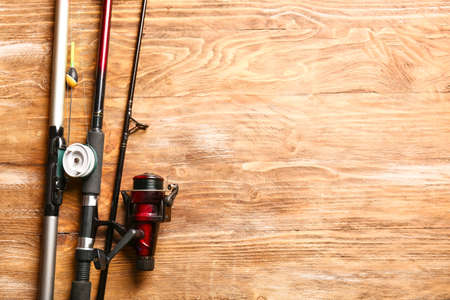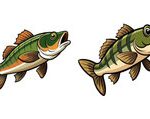1. Introduction to Rod Basics
When you’re just getting into fishing, choosing the right rod can feel overwhelming. But don’t worry — once you understand the basics of what makes up a fishing rod, it gets a lot easier to pick the one that fits your needs. Three major things to pay attention to are rod power, action, and material. These features determine how your rod performs on the water and can make a big difference in your fishing success.
Rod Power refers to how much force it takes to bend the rod. It’s closely tied to what kind of fish youre targeting. For example, if you’re going after bass or catfish, you’ll want a heavier power rod than if you’re fishing for trout or panfish.
Rod Action describes where along the blank (the main shaft of the rod) the bend happens when pressure is applied. This affects your casting distance, sensitivity, and hook-setting power.
Rod Material influences the rod’s weight, flexibility, and durability. Most modern rods are made from graphite, fiberglass, or a combination of both.
The table below gives a quick overview of these three elements:
| Feature | Description | Why It Matters |
|---|---|---|
| Rod Power | The strength needed to bend the rod (e.g., ultralight to heavy) | Affects what size fish you can handle and what lures/baits to use |
| Rod Action | The point where the rod bends under pressure (e.g., fast to slow) | Affects casting distance, sensitivity, and control during hooksets |
| Rod Material | The type of material used in the blank (e.g., graphite, fiberglass) | Affects weight, sensitivity, durability, and overall feel |
If you want better results on the water — whether youre casting from shore or on a boat — understanding these key components will help you choose a rod that matches your style and target species. Think of your fishing rod as an extension of your arm; having the right one means more bites, better hooksets, and more fun every time you go out.
2. What is Rod Power?
Rod power refers to the amount of force or pressure needed to bend a fishing rod. It’s often described using terms like ultra-light, light, medium, medium-heavy, and heavy. Choosing the right rod power is important because it affects how your rod handles different fish sizes, casting weight, and hook-setting ability.
Understanding Rod Power Ratings
Each rod power rating is designed for specific fishing conditions and target species. Heres a quick breakdown:
| Rod Power | Best For | Lure Weight Range | Line Strength |
|---|---|---|---|
| Ultra-Light | Panfish, trout, small streams | 1/32 – 3/8 oz | 1 – 6 lb test |
| Light | Trout, small bass, finesse fishing | 1/16 – 1/4 oz | 4 – 8 lb test |
| Medium | Bass, walleye, inshore saltwater | 1/4 – 3/4 oz | 6 – 12 lb test |
| Medium-Heavy | Larger bass, pike, catfish | 3/8 – 1 oz | 10 – 20 lb test |
| Heavy | Muskie, big catfish, saltwater game fish | 3/4 – 2 oz+ | 15 – 30+ lb test |
How Rod Power Affects Your Fishing Experience
Casting Distance & Accuracy
Lighter rods allow for more delicate casts with lighter lures, which is great when targeting smaller fish or fishing in clear water where subtlety matters. Heavier rods are better suited for casting heavier lures or fishing in windy conditions.
Hook-Setting Power
The stiffer (heavier) the rod, the more power you have to drive the hook into a fishs mouth—especially important for species with tough jaws like bass or muskie. Lighter rods need less effort but may not be ideal for hard hook sets.
Matching Rod Power to Your Target Fish and Techniques
| Fishing Style or Species | Recommended Rod Power |
|---|---|
| Panfish with small jigs or live bait | Ultra-Light or Light |
| Bass fishing with soft plastics or crankbaits | Medium to Medium-Heavy |
| Casting large swimbaits or frogs in heavy cover | Heavy |
| Saltwater inshore species like redfish or snook | Medium to Medium-Heavy |
| Trolling for catfish or muskie in rivers or lakes | Heavy |
Selecting the right rod power depends on what youre fishing for and how you plan to do it. By understanding these basics, youll have better control over your casts and more success landing your catch.
![]()
3. Understanding Rod Action
When youre picking out a fishing rod, one of the most important things to understand is its “action.” Rod action refers to how much and where a rod bends when pressure is applied. This affects your casting distance, hook-setting power, lure presentation, and how well you can feel a bite.
What Is Rod Action?
Rod action describes how quickly the rod returns to its neutral position after being flexed. It also tells you where the rod bends along the blank (the main shaft of the rod). There are three main types of rod action: slow, moderate, and fast.
Types of Rod Action
| Action Type | Bend Location | Sensitivity | Lure Control | Best For |
|---|---|---|---|---|
| Slow | Bends throughout the rod | Low | More forgiving, great for light lures | Panfish, crankbaits, beginners needing forgiveness on casts |
| Moderate | Bends from the middle to tip | Medium | Balanced control and flexibility | Versatile setups, all-around use |
| Fast | Bends near the tip only | High | Crisp lure action and strong hooksets | Bass fishing, single-hook lures like worms or jigs |
Why Rod Action Matters for Beginners
If youre just getting started with fishing, choosing the right rod action can make a huge difference in your success and enjoyment. A fast action rod gives you better sensitivity—meaning you’ll feel those subtle bites more easily. On the other hand, a slower action rod offers more flexibility and forgiveness if youre still learning how to cast accurately.
Sensitivity and Feel
A faster rod gives you more feedback from what’s happening at the end of your line. This is great when targeting species that nibble lightly or when using techniques where detecting small movements is key.
Lure Presentation and Control
The type of action also affects how you present your bait or lure. For instance, fast rods give you precise control over twitching or jigging movements. Slow rods are better for letting crankbaits move naturally through water without pulling them too hard.
The Bottom Line on Rod Action for New Anglers
If youre unsure which action to go with, moderate action rods are often a safe bet for beginners. They offer a good mix of control and flexibility, making them suitable for many situations until you get a feel for your personal fishing style.
4. Materials Matter: Graphite, Fiberglass, and Blends
When youre picking out your first fishing rod, its easy to get overwhelmed by all the options—especially when it comes to what the rod is made of. The material of your rod plays a big role in how it performs on the water. It affects everything from how sensitive it is to bites, how far you can cast, and even how long it will last. Let’s break down the most common materials used in fishing rods—graphite, fiberglass, and composite blends—so you can make a smart choice based on your fishing style.
Graphite Rods
Graphite rods are super popular among anglers because they’re lightweight and very sensitive. That means youll feel even the slightest nibble from a fish. They also offer fast action, which makes them great for techniques that require quick hook sets like bass fishing. But keep in mind, graphite can be more brittle than other materials, so it might not be the best choice if youre rough on your gear or fishing in rugged conditions.
Pros:
- High sensitivity
- Lightweight
- Great for fast-action techniques
Cons:
- Less durable under heavy stress
- Can be more expensive
Fiberglass Rods
If youre looking for something tough and forgiving, fiberglass rods are a solid pick. They’re heavier than graphite but incredibly durable—perfect for beginners or anyone targeting hard-fighting fish like catfish or pike. Fiberglass rods usually have a slower action, which means they bend more throughout the blank. This makes them ideal for techniques like trolling or using crankbaits where a softer touch helps keep fish hooked.
Pros:
- Extremely durable and strong
- More affordable
- Ideal for slower-action fishing styles
Cons:
- Heavier weight
- Less sensitivity compared to graphite
Composite/Blend Rods
If you want the best of both worlds, consider a composite rod made from both graphite and fiberglass. These rods offer a balance between sensitivity and strength. They’re versatile enough for different fishing styles and can handle various conditions without sacrificing too much in any one area. For many beginner anglers, composite rods provide an excellent middle ground.
Pros:
- Balanced performance (sensitivity + durability)
- Versatile across multiple techniques
- Lighter than pure fiberglass with more strength than pure graphite
Cons:
- Might not excel in any single category
- Slightly higher cost than fiberglass-only rods
Quick Comparison Table
| Rod Material | Sensitivity | Durability | Weight | Best For |
|---|---|---|---|---|
| Graphite | High | Moderate | Lightweight | Bass fishing, finesse techniques |
| Fiberglass | Low to Moderate | High | Heavy | Trolling, crankbaiting, big fish species |
| Composite (Blend) | Moderate to High | High | Medium Weight | All-around versatility, beginners unsure of style yet |
No matter what type of rod material you choose, understanding its strengths and limitations will help you make better decisions on the water. Picking the right material isn’t just about comfort—it’s about improving your casting range, detecting bites faster, and keeping your gear reliable trip after trip.
5. Matching Rod Specs to Fishing Styles
Choosing the right rod isn’t just about picking one that feels good in your hand — it’s also about matching its power, action, and material to the type of fishing you plan to do. Whether youre targeting bass in a local pond, casting for trout in a mountain stream, or heading out for some saltwater action, the right rod specs can make all the difference.
Bass Fishing
Bass are aggressive fighters and often hang around structures like logs, rocks, or weed beds. A medium-heavy power rod with fast action gives you the backbone to pull them out of cover quickly while still being sensitive enough for accurate lure presentation.
Trout Fishing
When going after trout, especially in rivers or small streams, finesse is key. Light power rods with moderate to fast action work great here. They allow for delicate casts with lightweight lures or bait and provide enough sensitivity to feel subtle bites.
Saltwater Fishing
Saltwater species are usually bigger and stronger than freshwater fish, so you’ll need a rod that can handle the challenge. Medium-heavy to heavy power rods made from corrosion-resistant materials like graphite or composite blends are ideal. Fast or extra-fast action helps with strong hooksets in deeper water.
Finesse Techniques
Techniques like drop shotting or using soft plastics for finicky fish require a sensitive setup. A light to medium-light power rod with a fast action tip allows you to detect even the slightest nibble while maintaining control over your lure’s movement.
Fishing in Heavy Cover
If youre punching through thick vegetation or flipping into dense brush, youll need strength and precision. Go with a heavy power rod and fast action tip. This combo gives you the muscle needed to drag fish out of heavy cover without snapping your line.
Rod Spec Guide by Fishing Style
| Fishing Style | Rod Power | Rod Action | Recommended Material |
|---|---|---|---|
| Bass Fishing | Medium-Heavy | Fast | Graphite/Composite |
| Trout Fishing | Light | Moderate-Fast | Graphite/Fiberglass Blend |
| Saltwater Fishing | Medium-Heavy to Heavy | Fast to Extra-Fast | Graphite/Corrosion-Resistant Composite |
| Finesse Techniques | Light to Medium-Light | Fast | Sensitive Graphite |
| Heavy Cover Fishing | Heavy | Fast | High-Modulus Graphite/Composite |
Selecting the right rod based on what kind of fishing youre doing helps you cast better, feel more bites, and land more fish. Start by thinking about where and what youre fishing for — then choose the power, action, and material that suits that style best.


